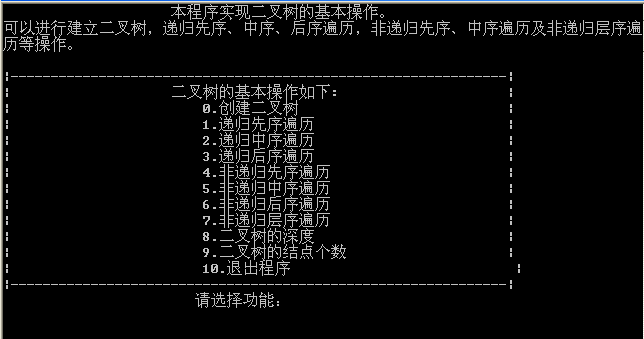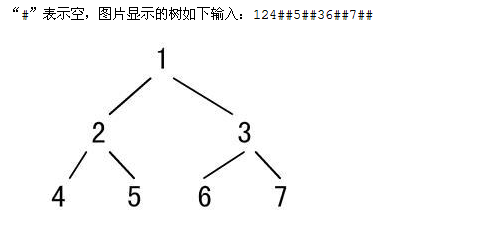先使用先序的方法建立一棵二叉树,然后分别使用递归与非递归的方法实现前序、中序、后序遍历二叉树,并使用了两种方法来进行层次遍历二叉树,一种方法就是使用STL中的queue,另外一种方法就是定义了一个数组队列,分别使用了front和rear两个数组的下标来表示入队与出队,还有两个操作就是求二叉树的深度、结点数。。。
- #include "iostream"
- #include "queue"
- #include "stack"
- using namespace std;
- //二叉树结点的描述
- typedef struct BiTNode
- {
- char data;
- struct BiTNode *lchild, *rchild; //左右孩子
- }BiTNode,*BiTree;
- //按先序遍历创建二叉树
- //BiTree *CreateBiTree() //返回结点指针类型
- //void CreateBiTree(BiTree &root) //引用类型的参数
- void CreateBiTree(BiTNode **root) //二级指针作为函数参数
- {
- char ch; //要插入的数据
- scanf("\n%c", &ch);
- //cin>>ch;
- if(ch=='#')
- *root = NULL;
- else
- {
- *root = (BiTNode *)malloc(sizeof(BiTNode));
- (*root)->data = ch;
- printf("请输入%c的左孩子:",ch);
- CreateBiTree(&((*root)->lchild));
- printf("请输入%c的右孩子:",ch);
- CreateBiTree(&((*root)->rchild));
- }
- }
- //前序遍历的算法程序
- void PreOrder(BiTNode *root)
- {
- if(root==NULL)
- return ;
- printf("%c ", root->data); //输出数据
- PreOrder(root->lchild); //递归调用,前序遍历左子树
- PreOrder(root->rchild); //递归调用,前序遍历右子树
- }
- //中序遍历的算法程序
- void InOrder(BiTNode *root)
- {
- if(root==NULL)
- return ;
- InOrder(root->lchild); //递归调用,前序遍历左子树
- printf("%c ", root->data); //输出数据
- InOrder(root->rchild); //递归调用,前序遍历右子树
- }
- //后序遍历的算法程序
- void PostOrder(BiTNode *root)
- {
- if(root==NULL)
- return ;
- PostOrder(root->lchild); //递归调用,前序遍历左子树
- PostOrder(root->rchild); //递归调用,前序遍历右子树
- printf("%c ", root->data); //输出数据
- }
- void PreOrder_Nonrecursive(BiTree T) //先序遍历的非递归
- {
- stack<BiTree> S;
- BiTree p;
- S.push(T); //根指针进栈
- while(!S.empty()) //栈空时结束
- {
- while((p=S.top()) && p)
- {
- cout<<p->data<<" ";
- S.push(p->lchild);
- } //向左走到尽头
- S.pop(); //弹出堆栈
- if(!S.empty())
- {
- p=S.top();
- S.pop();
- S.push(p->rchild); //向右走一步
- }
- }
- }
- void InOrderTraverse(BiTree T) //中序遍历的非递归
- {
- stack<BiTree> S;
- BiTree p;
- S.push(T); //根指针进栈
- while(!S.empty())
- {
- while((p=S.top()) && p)
- S.push(p->lchild); //向左走到尽头
- S.pop(); //空指针退栈
- if(!S.empty())
- {
- p=S.top();
- S.pop();
- cout<<p->data<<" ";
- S.push(p->rchild);
- }
- }
- }
- void PostOrder_Nonrecursive(BiTree T) //后序遍历的非递归
- {
- stack<BiTree> S;
- BiTree p=T,q=NULL;
- while(p!=NULL || !S.empty()) //栈空时结束
- {
- while(p!=NULL)
- {
- S.push(p);
- p=p->lchild;
- }
- p=S.top();
- if(p->rchild==NULL || p->rchild==q)
- {
- cout<<p->data<<" ";
- q=S.top();
- S.pop();
- p=NULL;
- }
- else
- p=p->rchild;
- }
- }
- int visit(BiTree T)
- {
- if(T)
- {
- printf("%c ",T->data);
- return 1;
- }
- else
- return 0;
- }
- void LeverTraverse(BiTree T) //方法一、非递归层次遍历二叉树
- {
- queue <BiTree> Q;
- BiTree p;
- p = T;
- if(visit(p)==1)
- Q.push(p);
- while(!Q.empty())
- {
- p = Q.front();
- Q.pop();
- if(visit(p->lchild) == 1)
- Q.push(p->lchild);
- if(visit(p->rchild) == 1)
- Q.push(p->rchild);
- }
- }
- void LevelOrder(BiTree BT) //方法二、非递归层次遍历二叉树
- {
- BiTNode *queue[10];//定义队列有十个空间
- if (BT==NULL)
- return;
- int front,rear;
- front=rear=0;
- queue[rear++]=BT;
- while(front!=rear)//如果队尾指针不等于对头指针时
- {
- cout<<queue[front]->data<<" "; //输出遍历结果
- if(queue[front]->lchild!=NULL) //将队首结点的左孩子指针入队列
- {
- queue[rear]=queue[front]->lchild;
- rear++; //队尾指针后移一位
- }
- if(queue[front]->rchild!=NULL)
- {
- queue[rear]=queue[front]->rchild; //将队首结点的右孩子指针入队列
- rear++; //队尾指针后移一位
- }
- front++; //对头指针后移一位
- }
- }
- int depth(BiTNode *T) //树的深度
- {
- if(!T)
- return 0;
- int d1,d2;
- d1=depth(T->lchild);
- d2=depth(T->rchild);
- return (d1>d2?d1:d2)+1;
- //return (depth(T->lchild)>depth(T->rchild)?depth(T->lchild):depth(T->rchild))+1;
- }
- int CountNode(BiTNode *T)
- {
- if(T == NULL)
- return 0;
- return 1+CountNode(T->lchild)+CountNode(T->rchild);
- }
- int main(void)
- {
- BiTNode *root=NULL; //定义一个根结点
- int flag=1,k;
- printf(" 本程序实现二叉树的基本操作。\n");
- printf("可以进行建立二叉树,递归先序、中序、后序遍历,非递归先序、中序遍历及非递归层序遍历等操作。\n");
- while(flag)
- {
- printf("\n");
- printf("|--------------------------------------------------------------|\n");
- printf("| 二叉树的基本操作如下: |\n");
- printf("| 0.创建二叉树 |\n");
- printf("| 1.递归先序遍历 |\n");
- printf("| 2.递归中序遍历 |\n");
- printf("| 3.递归后序遍历 |\n");
- printf("| 4.非递归先序遍历 |\n");
- printf("| 5.非递归中序遍历 |\n");
- printf("| 6.非递归后序遍历 |\n");
- printf("| 7.非递归层序遍历 |\n");
- printf("| 8.二叉树的深度 |\n");
- printf("| 9.二叉树的结点个数 |\n");
- printf("| 10.退出程序 |\n");
- printf("|--------------------------------------------------------------|\n");
- printf(" 请选择功能:");
- scanf("%d",&k);
- switch(k)
- {
- case 0:
- printf("请建立二叉树并输入二叉树的根节点:");
- CreateBiTree(&root);
- break;
- case 1:
- if(root)
- {
- printf("递归先序遍历二叉树的结果为:");
- PreOrder(root);
- printf("\n");
- }
- else
- printf(" 二叉树为空!\n");
- break;
- case 2:
- if(root)
- {
- printf("递归中序遍历二叉树的结果为:");
- InOrder(root);
- printf("\n");
- }
- else
- printf(" 二叉树为空!\n");
- break;
- case 3:
- if(root)
- {
- printf("递归后序遍历二叉树的结果为:");
- PostOrder(root);
- printf("\n");
- }
- else
- printf(" 二叉树为空!\n");
- break;
- case 4:
- if(root)
- {
- printf("非递归先序遍历二叉树:");
- PreOrder_Nonrecursive(root);
- printf("\n");
- }
- else
- printf(" 二叉树为空!\n");
- break;
- case 5:
- if(root)
- {
- printf("非递归中序遍历二叉树:");
- InOrderTraverse(root);
- printf("\n");
- }
- else
- printf(" 二叉树为空!\n");
- break;
- case 6:
- if(root)
- {
- printf("非递归后序遍历二叉树:");
- PostOrder_Nonrecursive(root);
- printf("\n");
- }
- else
- printf(" 二叉树为空!\n");
- break;
- case 7:
- if(root)
- {
- printf("非递归层序遍历二叉树:");
- //LeverTraverse(root);
- LevelOrder(root);
- printf("\n");
- }
- else
- printf(" 二叉树为空!\n");
- break;
- case 8:
- if(root)
- printf("这棵二叉树的深度为:%d\n",depth(root));
- else
- printf(" 二叉树为空!\n");
- break;
- case 9:
- if(root)
- printf("这棵二叉树的结点个数为:%d\n",CountNode(root));
- else
- printf(" 二叉树为空!\n");
- break;
- default:
- flag=0;
- printf("程序运行结束,按任意键退出!\n");
- }
- }
- system("pause");
- return 0;
- }
运行效果图如下:

分别输入:
1
2
4
#
#
5
#
#
3
6
#
#
7
#
#
就可以构造如下图所示的二叉树了。。

后序遍历非递归的另外一种写法:
- /*
- 后序遍历由于遍历父节点是在遍历子节点之后,而且左节点和右节点遍历后的行为不一样,
- 所以需要用变量来记录前一次访问的节点,根据前一次节点和现在的节点的关系来确定具体执行什么操作
- */
- void Postorder(BiTree T)
- {
- if(T == NULL)
- return ;
- stack<BiTree> s;
- BiTree prev = NULL , curr = NULL;
- s.push(T);
- while(!s.empty())
- {
- curr = s.top();
- if(prev == NULL || prev->lchild == curr || prev->rchild == curr)
- {
- if(curr->lchild != NULL)
- s.push(curr->lchild);
- else if(curr->rchild != NULL)
- s.push(curr->rchild);
- }
- else if(curr->lchild == prev)
- {
- if(curr->rchild != NULL)
- s.push(curr->rchild);
- }
- else
- {
- cout<<curr->data;
- s.pop();
- }
- prev = curr;
- }
- }
输入二叉树中的两个节点,输出这两个结点在数中最低的共同父节点。
思路:遍历二叉树,找到一条从根节点开始到目的节点的路径,然后在两条路径上查找共同的父节点。
- // 得到一条从根节点开始到目的节点的路径
- bool GetNodePath(TreeNode *pRoot , TreeNode *pNode , vector<TreeNode *> &path)
- {
- if(pRoot == NULL)
- return false;
- if(pRoot == pNode)
- return true;
- else if(GetNodePath(pRoot->lchild , pNode , path) )
- {
- path.push_back(pRoot->lchild);
- return true;
- }
- else if(GetNodePath(pRoot->rchild , pNode , path) )
- {
- path.push_back(pRoot->rchild);
- return true;
- }
- return false;
- }
- TreeNode *GetLastCommonNode(const vector<TreeNode *> &path1 , const vector<TreeNode *> &path2)
- {
- vector<TreeNode *>::const_iterator iter1 = path1.begin();
- vector<TreeNode *>::const_iterator iter2 = path2.begin();
- TreeNode *pLast;
- while(iter1 != path1.end() && iter2 != path2.end() )
- {
- if(*iter1 == *iter2)
- pLast = *iter1;
- else
- break;
- iter1++;
- iter2++;
- }
- return pLast;
- }
- TreeNode *GetLastCommonParent(TreeNode *pRoot , TreeNode *pNode1 , TreeNode *pNode2)
- {
- if(pRoot == NULL || pNode1 == NULL || pNode2 == NULL)
- return NULL;
- vector<TreeNode *> path1;
- GetNodePath(pRoot , pNode1 , path1);
- vector<TreeNode *> path2;
- GetNodePath(pRoot , pNode2 , path2);
- return GetLastCommonNode(path1 , path2);
- }